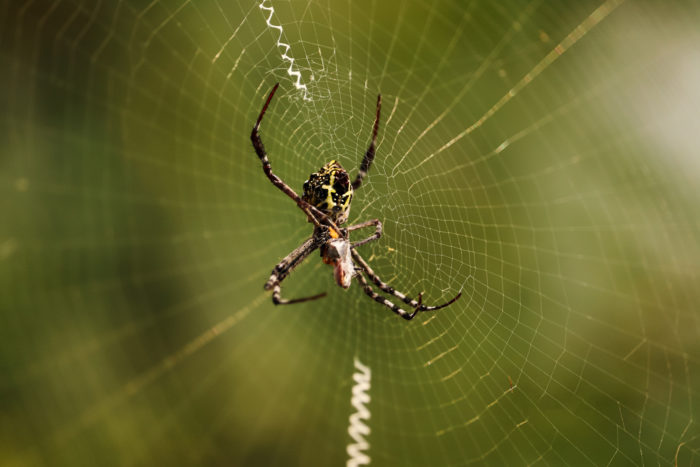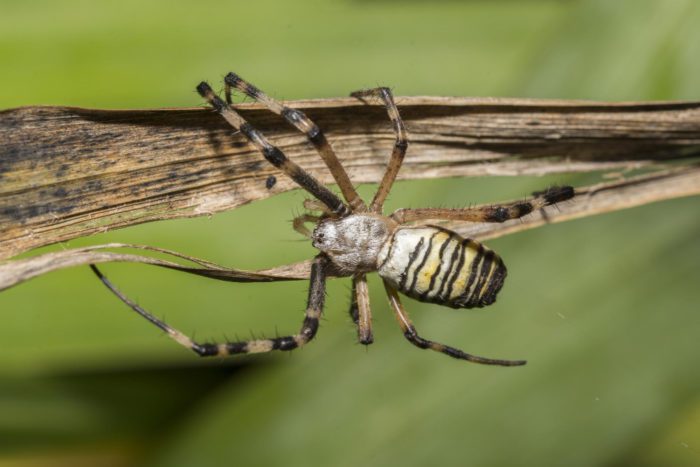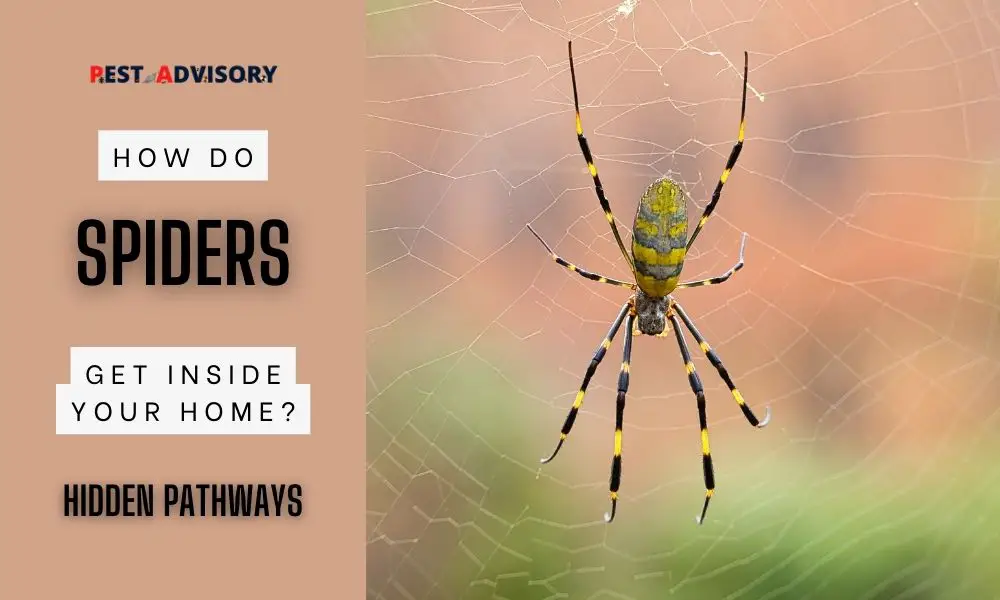Have you ever found yourself startled by an unexpected encounter with a spider in the comfort of your own home?
The mysterious ways these eight-legged creatures infiltrate our living spaces may leave you wondering.
In this captivating exploration, we peel back the veil and uncover the hidden pathways spiders exploit to gain entry.
Get ready to unravel the enigma as we reveal how these stealthy arachnids find their way into our houses.

Through Openings and Cracks
Spiders have a remarkable ability to exploit small openings and cracks, allowing them to enter buildings and find their way into our homes.
Here is some detailed information on how spiders navigate through these entry points
Exterior Access Points
Spiders can find their way inside houses through various exterior access points, taking advantage of even the smallest gaps or openings
Damaged Screens
Torn or poorly fitted window screens provide an easy pathway for spiders to crawl through. Even a small tear or gap is enough for them to squeeze in.
Poorly Sealed Windows and Doors
Gaps or cracks around windows and doors can serve as entry points for common house spiders we find at home. Over time, the caulking or weatherstripping around these areas may deteriorate, creating opportunities for spiders to enter.
Cracks in Walls and Foundations
Spiders can exploit tiny cracks in the exterior walls or foundation of a building. These cracks may develop naturally over time due to settling, weathering, or structural issues.
Spiders can crawl through these openings and find their way into the interior of the house.
Utility Openings
Spiders are adept at utilizing utility openings to gain access to homes. These openings can include vents, pipes, electrical conduits, and other small gaps that connect the exterior and interior of a building
Vents
Spiders may enter houses through various types of vents, such as those for HVAC systems, bathroom fans, or dryer vents. These openings provide a direct route for spiders to crawl inside.
Pipes and Conduits
Gaps around pipes, plumbing penetrations, and electrical conduits are potential entry points for spiders. These openings may be present in areas like the kitchen, bathroom, or utility rooms.
Prevent Spiders from Entering Your Home Through Openings and Cracks
Spiders have a unique ability to flatten their bodies and maneuver through narrow spaces.
They can squeeze into openings that may seem impossibly small, thanks to their flexible exoskeleton and lack of a rigid skeletal structure.
Once inside, they can explore different areas of the house in search of suitable habitats and prey.
Regular Inspection
Conduct routine inspections of the exterior of your house, paying attention to areas with potential entry points, such as windows, doors, vents, and utility openings.
Seal Gaps and Cracks
Use caulk, weatherstripping, or appropriate sealants to fill in gaps and cracks around windows, doors, and utility openings. This helps create a barrier that prevents spiders from entering.
Repair Damaged Screens
Replace or repair torn window screens to ensure they remain intact and free of gaps.
By addressing these vulnerabilities and implementing preventive measures, you can significantly reduce the likelihood of spiders finding their way into your home through openings and cracks.

Hitchhiking and Infestation
Spiders can make their way into our homes through various means, including hitchhiking or taking advantage of existing infestations.
Understanding these factors is crucial in preventing spiders from infiltrating your living space.
Here’s a closer look at how spiders hitchhike and exploit infestations
Outdoor Infestations
Spiders may already be present in outdoor areas near your house, and they can inadvertently find their way inside through natural movement or human activities.
Common scenarios include
Gardens and Vegetation
If you have a garden or lush vegetation surrounding your home, spiders may reside there. As you spend time outdoors, spiders can attach themselves to your clothing, shoes, or objects, unknowingly hitching a ride into your home.
Woodpiles and Debris
Spiders often seek refuge in woodpiles, leaf litter, or debris near your house. When bringing in firewood or moving outdoor materials, spiders can easily transfer from these infested areas into your home.
Infestation Transfer
Spiders can enter houses by hitching a ride on infested items or by exploiting pre-existing infestations.
Here are some common scenarios
Plants and Flowers
Spiders may inhabit potted plants or cling to cut flowers. When bringing new plants indoors or placing fresh flower arrangements in your home, you may unintentionally introduce spiders.
Furniture and Belongings
Infested furniture, storage boxes, or other belongings that have been stored in areas where spiders are present can become a source of spider introduction. When moving or unpacking these items, spiders can emerge and find their way into your home.
Preventing Hitchhiking and Infestation
To minimize the chances of spiders hitchhiking or taking advantage of existing infestations, consider the following preventive measures
Shake and Inspect
Before entering your home, thoroughly inspect clothing, shoes, and outdoor items for any spiders or webs. Give them a good shake to dislodge any hidden hitchhikers.
Examine Plants and Flowers
Inspect plants and flowers before bringing them indoors. Look for webs, spiders, or other signs of infestation. Consider carefully examining the soil or repotting the plants to ensure you’re not introducing spiders into your home.
Inspect and Clean Infested Items
Before moving or bringing in infested furniture or storage boxes, inspect them carefully. If infested, consider treating or eliminating the infestation before introducing the items into your home.
By being vigilant and taking these precautions, you can significantly reduce the chances of spiders hitchhiking or taking advantage of existing infestations to enter your home.

Seeking Shelter and Food
Spiders are often drawn to indoor environments in search of suitable shelter and a reliable food source.
Understanding the factors that attract spiders to homes can help you implement effective strategies to minimize their presence.
Here’s a closer look at how spiders seek shelter and food indoors
Indoor Environmental Factors
Certain aspects of the indoor environment make homes attractive to spiders. These factors provide the necessary conditions for spiders to survive and thrive:
Warmth and Comfort
Spiders are ectothermic creatures, meaning their body temperature is influenced by their surroundings. They seek out warm areas within homes, such as basements, attics, or rooms with cozy heating sources, to establish their shelter.
Humidity and Moisture
Some spider species prefer higher humidity levels. Areas with moisture, such as bathrooms, kitchens, or damp basements, can create an appealing environment for spiders seeking shelter.
Dark and Undisturbed Spaces
Spiders are nocturnal creatures and prefer dark, undisturbed areas where they can hide during the day. Cluttered storage spaces, neglected corners, and areas behind furniture or appliances offer ideal hiding spots for spiders.
Chasing Prey
Spiders enter homes in pursuit of their primary food source: other insects. If your home has an existing insect population, spiders may be attracted to the available prey
Insect Infestations
If your house has an infestation of common household pests like flies, mosquitoes, ants, or gnats, spiders may follow the scent of these insects and find their way inside.
Light Sources
Outdoor lighting or bright indoor lights at night can attract insects, creating a feeding ground for spiders. When insects gather around these light sources, spiders may be enticed to enter the house to take advantage of the abundant prey.
Preventing Shelter-Seeking and Food-Seeking Behavior
To discourage spiders from seeking shelter and food in your home, consider the following preventive measures
Declutter and Clean
Regularly clean and organize your living spaces, paying attention to areas where spiders are likely to hide, such as basements, attics, and storage areas. Remove clutter and vacuum regularly to eliminate potential hiding spots.
Reduce Moisture
Address any sources of excessive moisture or leaks in your home. Repair plumbing issues, use dehumidifiers in damp areas, and ensure proper ventilation to decrease humidity levels.
Control other Insects
Implement effective pest control measures to prevent insect infestations. Seal cracks and crevices, eliminate food sources, and use appropriate pest control methods to reduce the presence of insects that spiders feed on.
Adjust Lighting
Consider using yellow or sodium vapor light bulbs for outdoor lighting, as they are less attractive to insects. Use blinds or curtains to block indoor lights from shining outward, minimizing the insect-attracting effect.
By creating an environment that is less appealing to spiders, addressing potential hiding spots, and managing insect populations, you can make your home less inviting for these arachnids.

Conclusion
In the intricate dance between spiders and our homes, we’ve uncovered the hidden pathways they exploit to gain entry.
By understanding their methods, we regain control. Seal the cracks, mend the screens, and keep a watchful eye on potential infestations.
With these preventative measures, we can create a sanctuary free from unexpected eight-legged guests. Embrace a spider-free abode, and reclaim your peace of mind.
